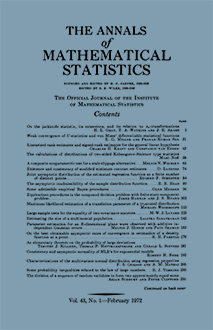Abstract
Let $x_1, x_2, cdots, x_n$ be $n$ independent and identically distributed random variables whose distribution depends on a parameter $\theta, \theta \in \Theta$. Let $\Theta_0$ be a subset of $\Theta$ and consider the test of the hypothesis that $\theta \in \Theta_0. L_n (x_1, \cdots, x_n)$ is the level attained by a test statistic $T_n(x_1, \cdots, x_n)$ in the sense that it is the maximum probability under the hypothesis of obtaining a value large or larger than $T_n$ where large values of $T_n$ are significant for the hypothesis. Under some assumptions Bahadur [3] showed that where a non-null $\theta$ obtains $L_n$ cannot tend to zero at a rate faster than $\lbrack\rho(\theta)\rbrack^n$ where $\rho$ is a function defined in terms Kullback-Liebler information numbers. In this paper this result has been shown to be true without any assumptions whatsoever (Theorem 1). Some aspects of the relationship between the rate of convergence of $L_n$ and rate of convergence of the size of the tests are also studied and an equivalence property is shown (Theorem 2).
Citation
M. Raghavachari. "On a Theorem of Bahadur on the Rate of Convergence of Test Statistics." Ann. Math. Statist. 41 (5) 1695 - 1699, October, 1970. https://doi.org/10.1214/aoms/1177696813
Information





